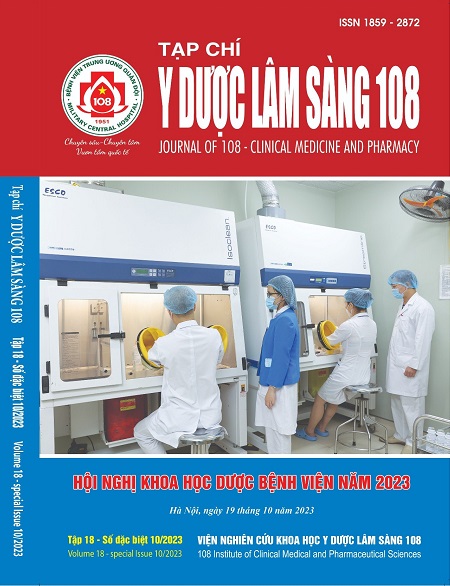Evaluation of screening results for carbapenem-resistant Enterobacteriace at Intensive Care Units, 108 Military Central Hospital
Main Article Content
Keywords
Abstract
Objective: To describe the percentage of carbapenem-resistant Enterobacteriace in Intensive Care Units of 108 Military Central Hospital from Jan 2023 to June 2023. Subject and method: Descriptive and prospective study of rectal swab in 937 ICU patients (internal, organ transplant surgical and neurological) from Jan. 2023 to June 2023. The culture was made in disc ChromID CARBA supplied by Biomerieux. CRE positive patients were isolated. CRE negative patients were re-screened after 7 days, among those, positive patients would be isolated. All patients were screened once again before being discharged from ICU. Result and conclusion: CRE (+) percentage at hospitalization was 35.11%, mainly Klebsiella pneumoniae (59.47%), E. coli (12.94%), and others Enterobacteriacaea. There were also other bacteria: Acenitomacter baumannii, Pseudomonas aeruginosa resistance carbapenem. The percentages of nosocomial infections were: CLABSI 2.83/1000 IV line-day, CAUTI 2.71/1000 catheter-day, PAVP 4.55/1000 ventilation-day. The main bacteria were A. baumanii, P. aeruginosa, K. pneumoniae, E. coli.
Article Details
References
2. Garpvall K, Duong V, Linnros S et al (2021) Admission screening and cohort care decrease carbapenem resistant enterobacteriaceae in Vietnamese pediatric ICU’s. Antimicrob Resist Infectiot Control 10: 128.
3. Dien M Tran, Mattias Larsson, Linus Olson et al (2019) High prevalence of colonisation with carbapenem-resistant enterobacteriaceae among patients admitted to Vietnam hospitals: Risk factors and burden of disease. Journal of infection 79: 115-122.
4. Centers for Disease Control and Prevention: National Center for Emerging and Zoonotic Infectious Diseases. Division of Healthcare Quality. Facility Guidance for Control of Carbapenem Resistant Enterobacteriaceae (CRE) November 2015 Update; 2015. [cited 2019 May 27]. Available from: https://www.cdc.gov/hai/pdfs/cre/CRE-guidance-508.pdf
5. Le NK, Hf W, Vu PD, Khu DT, Le HT, Hoang BT et al (2016) High prevalence of hospital-acquired infections caused by gram-negative carbapenem resistant strains in Vietnamese pediatric ICUs: A multi-centre point prevalence survey. Medicine (Baltimore) 95(27): 4099.
6. Phu VD, Wertheim HF, Larsson M, Nadjm B, Dinh QD, Nilsson LE et al (2016) Burden of hospital acquired infections and antimicrobial use in vietnamese adult intensive care units. PLoS One 11(1): 0147544.
7. Centers for Disease Control and Prevention (2009) Guidance for control of infections with carbapenem-resistant or carbapenemase producing Enterobacteriaceae inacute care facilities. MMWR Morb Mortal Wkly Rep 58(10): 256-260.
8. Merzougui L, Barhoumi T, Guizani T et al (2018). Nosocomial infections in the Intensive Care Unit: annual incidence rate and clinical aspects. The Pan African medical journal 30: 143.
 ISSN: 1859 - 2872
ISSN: 1859 - 2872
